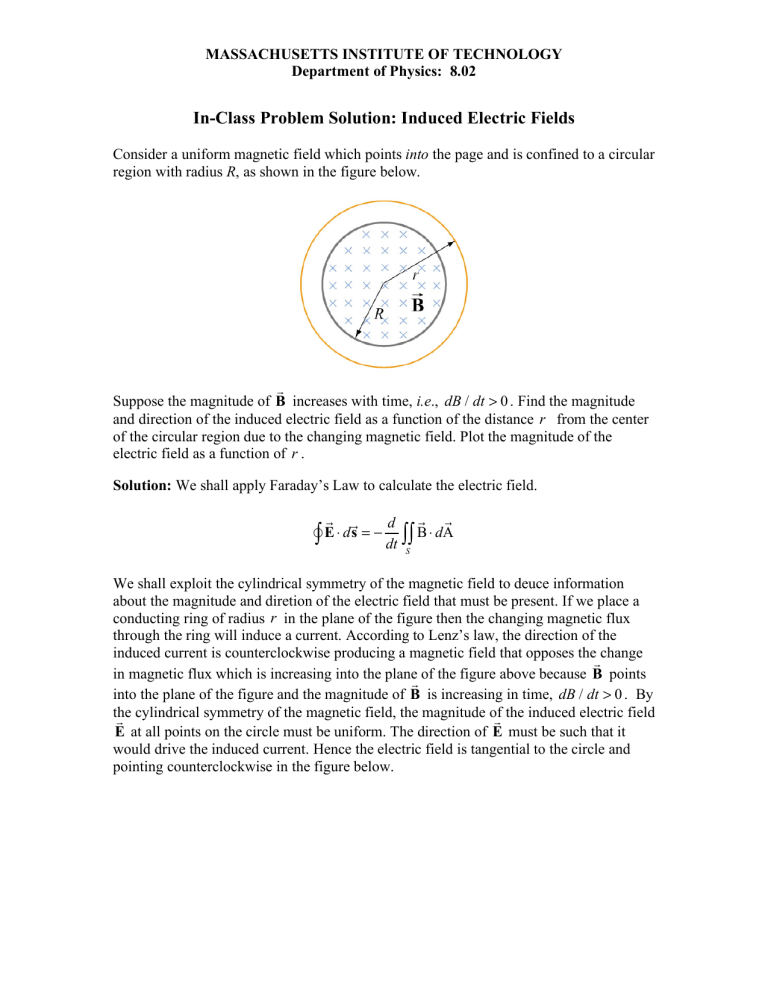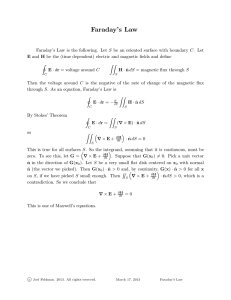Induced Electric Fields

MASSACHUSETTS INSTITUTE OF TECHNOLOGY
Department of Physics: 8.02
In-Class Problem Solution: Induced Electric Fields
Consider a uniform magnetic field which points into the page and is confined to a circular region with radius R , as shown in the figure below.
Suppose the magnitude of B increases with time, i.e
., dB / dt > 0 . Find the magnitude and direction of the induced electric field as a function of the distance r from the center of the circular region due to the changing magnetic field. Plot the magnitude of the electric field as a function of r .
Solution: We shall apply Faraday’s Law to calculate the electric field.
" "
!
E !
d = # d dt
""
S
!
B !
d
!
A
We shall exploit the cylindrical symmetry of the magnetic field to deuce information about the magnitude and diretion of the electric field that must be present. If we place a conducting ring of radius r in the plane of the figure then the changing magnetic flux through the ring will induce a current. According to Lenz’s law, the direction of the in magnetic flux which is increasing into the plane of the figure above because into the plane of the figure and the magnitude of B is increasing in time,
dB
B points
/ dt > 0 . By
!
E at all points on the circle must be uniform. The direction of
!
E must be such that it would drive the induced current. Hence the electric field is tangential to the circle and pointing counterclockwise in the figure below.
MASSACHUSETTS INSTITUTE OF TECHNOLOGY
Department of Physics: 8.02
We now choose the integration path on the left hand side of Faraday’s Law to be a circle of radius r . We choose to integrate in direction that the electric field is pointing, the counterclockwise direction. Then
Faraday’s Law becomes d
!
= rd !
ˆ
!
that points in the
. The integral on the left-hand-side of
!
E !
d "
0
2 $
"
" = E
# rd # = E
#
2 $ r where E
!
is the component of the electric field in the !
-direction.
We now direct our attention to the right-hand-side of Faraday’s Law. We begin by choosing for our surface the flat disk of radius need to choose the unit normal ˆ
r . Because this is an open surface we
in the area element area d A = n dA according to the right-hand rule as applied to the integration direction. If we integrate in a counterclockwise direction then ˆ points into the page, the dot product
!
B !
d
!
A = " BdA .
In the region r < R , the rate of change of magnetic flux is
!
d dt
## disk
!
B " d
!
A = !
d dt
## disk
!
BdA = dB dt
$ r 2 (0.0.1)
Then using Faraday’s Law we have
E
!
2 " r = dB dt
" r 2 which implies
E
!
= r
2 dB dt
For r > R , the integral on the left-hand-side of Faraday’s law is the same
(0.0.2)
(0.0.3)
MASSACHUSETTS INSTITUTE OF TECHNOLOGY
Department of Physics: 8.02
!
d dt
## disk
"
"
!
E !
d
!
B " d
!
A
=
=
"
0
!
2 $ d
E dt
# rd
## disk
# = E
!
BdA
#
=
2 $ r .
Because the magnetic field is zero for r
> R , the time changing magnetic flux is now dB dt
$ R 2 .
Therefore applying Faraday’s Law yields dB dt
" R 2 (0.0.4) or
E
!
2 " r =
E
!
=
R 2
2 r dB dt
(0.0.5)
A plot of E
!
as a function of r is shown in the figure below.





